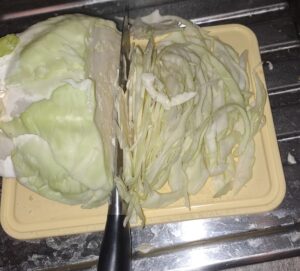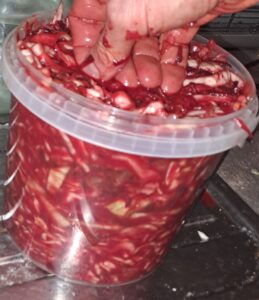—>Main Page -Because Your Health is Important
—>Bedscape.com –Because Your Sleep is Important
In recent years, fermented foods have been gaining remarkable popularity and making their way onto the plates of health-conscious individuals worldwide. From sauerkraut and kimchi to yogurt and kombucha, fermented foods have transcended cultural boundaries to become a staple in many diets. This surge in interest can be attributed to both the unique flavors and the numerous health benefits associated with these foods.
At the heart of fermented foods lies a fascinating process called fermentation. It is a natural transformation that occurs when microorganisms, such as bacteria or yeast, convert the sugars present in food into alcohol, acids, or gases. This transformative process not only imparts distinctive flavors, textures, and aromas to the food but also contributes to its preservation by creating an environment unfavorable for harmful bacteria. Fermentation has been used for centuries as a means to extend the shelf life of perishable foods, enabling communities to store and consume nutrient-rich provisions throughout the year. This age-old technique has paved the way for the creation of a wide array of fermented delicacies, each with its unique cultural heritage and culinary traditions.
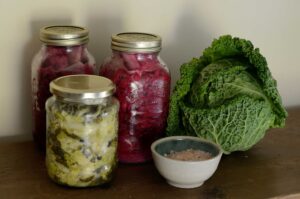
Beyond their tantalizing taste and historical significance, fermented foods offer an impressive array of health benefits that go far beyond conventional sustenance. From supporting gut health and boosting immune function to improving nutrient bioavailability and promoting mental well-being, the consumption of fermented foods has been linked to a host of positive outcomes. In this blog post, we will delve into the transformative power of fermented foods and explore the compelling reasons why they deserve a prominent place in your daily diet. So, let’s embark on this journey to uncover the incredible benefits that fermented foods can bestow upon your overall health and well-being. At the end of the article you will find a recipe -the Superman Sauerkraut-, that potentially can change your life and health!
The MOST COMPLETE Nutritional Supplements
EVER CREATED!
For less than 60 cents a day!!!
Understanding Fermentation
Fermentation is a natural metabolic process that occurs when microorganisms, such as bacteria, yeasts, or fungi, convert carbohydrates (sugars and starches) into alcohol, acids, or gases. It is an ancient technique that has been employed by humans for thousands of years to preserve and transform various foods. During fermentation, these microorganisms break down the complex molecules in food, releasing enzymes that facilitate the conversion of sugars into different compounds. This transformative process brings about notable changes in the taste, texture, and nutritional composition of the food. It not only enhances the flavors by producing unique compounds but also contributes to the preservation of the food by creating an acidic or alcoholic environment that inhibits the growth of harmful bacteria.
Overview of the fermentation process and its significance in food production
The fermentation process begins with the selection of the desired microorganisms, which can vary depending on the type of food being fermented. These microorganisms are introduced to the food, and under suitable conditions (temperature, moisture, and time), they initiate the fermentation process. During fermentation, the microorganisms consume the sugars present in the food and produce various byproducts, such as lactic acid, acetic acid, or carbon dioxide, depending on the specific microorganisms involved.
The significance of fermentation in food production is multifaceted. Firstly, it acts as a natural method of preservation by creating an inhospitable environment for spoilage-causing bacteria. This allows communities to store and consume foods for longer periods, reducing waste and ensuring a continuous food supply. Additionally, fermentation enhances the digestibility of certain foods, making their nutrients more accessible to our bodies. It can also unlock new flavors and aromas, contributing to the culinary diversity and enjoyment of different cuisines.
Healthy Organic Weight Management Coffee with Mushrooms
– Less than 60 cents per cup
Yes, this is very likely the longest name for a coffee you’ve ever seen. But the truth is, with all of the amazing benefits and ingredients we’ve packed into this blend, we could have added even more words, like adaptogens, green tea, healthy fiber, maca, and especially delicious!
Not only does LiveGood Organic coffee combine the highest quality ingredients from the cleanest, most pure and lush places on the planet, it is the FIRST and ONLY coffee enhanced with healthy fiber to reduce hunger, formulated with maca to help support learning and memory while improving mood, plus green tea to promote healthy brain function and stimulate fat burning, AND adaptogens in the form of 6 of the world’s most powerful mushrooms to ease stress, support a healthy body, and help you feel great! No coffee on the planet provides as many benefits as LiveGood Healthy Organic Weight Management Coffee with Mushrooms
From the first time you taste our delicious blend, and experience the amazing results, you may never want to drink another coffee ever again!
Examples of common fermented foods and beverages
Fermented foods and beverages are found in virtually every culture around the world. Here are some examples of widely consumed fermented products:
- Sauerkraut: This traditional German dish consists of fermented cabbage that undergoes a process of lactic acid fermentation, resulting in a tangy and crunchy condiment.
- Kimchi: A staple in Korean cuisine, kimchi is made by fermenting vegetables, such as cabbage and radishes, with a mixture of spices, including chili pepper, garlic, and ginger. It offers a pungent and spicy flavor profile.
- Yogurt: A popular dairy product, yogurt is created by fermenting milk with lactic acid bacteria. The fermentation process converts lactose (milk sugar) into lactic acid, giving yogurt its creamy texture and tart taste. It is also a good source of probiotics.
- Kombucha: A fizzy and tangy beverage, kombucha is made by fermenting sweetened tea with a culture of bacteria and yeast known as a SCOBY (Symbiotic Culture of Bacteria and Yeast). This process produces a lightly effervescent drink with a slightly sour taste.
- Miso: An essential ingredient in Japanese cuisine, miso is a fermented soybean paste that is aged with the help of a fungus called koji. It imparts a rich umami flavor and is commonly used in soups, marinades, and dressings.
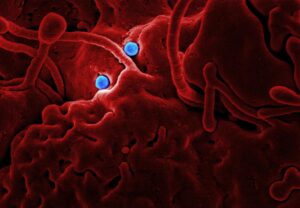
Gut Health: The Foundation of Well-being
A. Introduction to the gut microbiome and its importance
The human digestive system is home to trillions of microorganisms, collectively known as the gut microbiome. This complex ecosystem consists of diverse bacteria, yeasts, viruses, and other microbes that reside in our gastrointestinal tract. Far from being passive bystanders, these microorganisms play a crucial role in our overall health and well-being. The gut microbiome performs a myriad of functions, such as aiding in digestion, synthesizing vitamins, regulating metabolism, and supporting immune function. It also interacts closely with the cells lining the gut, influencing their development and functionality. Emerging research suggests that the composition and diversity of the gut microbiome are closely linked to various aspects of our health, including digestion, immune system function, mental health, and even chronic diseases.
How fermented foods promote a healthy gut flora
Fermented foods have long been recognized as allies in cultivating a healthy gut flora. The fermentation process itself encourages the growth of beneficial microorganisms, such as lactic acid bacteria and certain yeasts. These microbes not only contribute to the transformation of the food but also act as probiotics when consumed. Probiotics are live microorganisms that, when administered in adequate amounts, confer health benefits to the host. By consuming fermented foods, we introduce a diverse array of live probiotic cultures into our digestive system. These probiotics can help replenish and maintain a balanced gut microbiome, promoting the growth of beneficial bacteria and inhibiting the proliferation of harmful microbes. This balance is essential for optimal digestion, nutrient absorption, and overall gut health.
Role of probiotics in improving digestion and nutrient absorption
Probiotics, abundant in fermented foods, offer numerous benefits when it comes to digestion and nutrient absorption. Firstly, they aid in the breakdown of complex carbohydrates, proteins, and fats, making them easier for our bodies to digest. This can reduce digestive discomfort, such as bloating and gas, and enhance overall digestive efficiency. Moreover, probiotics play a vital role in the absorption of nutrients from our food. They help break down dietary fibers and other indigestible components, releasing valuable nutrients that might otherwise remain inaccessible. This improved nutrient bioavailability means that our bodies can derive more nourishment from the foods we consume, supporting optimal health and vitality. Additionally, probiotics contribute to maintaining the integrity of the gut lining. They help strengthen the barrier function of the intestinal wall, preventing harmful substances, toxins, and undigested particles from entering the bloodstream. This barrier function is essential in reducing inflammation and supporting immune system health.
The MOST COMPLETE Nutritional Supplement
EVER CREATED!
For less than 60 cents a day!!!
Benefits of Fermented Foods
The gut and the immune system share a remarkable connection, with approximately 70% of the body’s immune cells residing in the gastrointestinal tract. This close relationship is crucial for maintaining a robust immune response and defending against pathogens. The gut microbiome, influenced by factors such as diet and lifestyle, plays a pivotal role in regulating immune function. An imbalance or disruption in the gut microbiome can lead to immune dysregulation and increased susceptibility to infections and diseases. Fermented foods offer a natural and effective way to enhance immune responses. These foods contain live probiotic cultures that, when consumed, interact with the gut microbiome and influence immune function. Probiotics found in fermented foods can stimulate the production of antibodies and enhance the activity of immune cells, such as natural killer cells and T-cells, which are crucial for immune defense. Furthermore, fermented foods can modulate the gut microbiome by promoting the growth of beneficial bacteria. This shift in microbial composition positively impacts the immune system, as a diverse and balanced gut microbiome is associated with a more robust immune response. Fermented foods also contain bioactive compounds, such as short-chain fatty acids and antimicrobial peptides, which have immunomodulatory properties and support immune health.
Fermented foods have long been recognized for their potential in alleviating various digestive disorders. The beneficial microorganisms present in fermented foods, such as probiotics, can help restore balance in the gut microbiome, support digestion, and reduce inflammation in the digestive system. When consumed, probiotics found in fermented foods interact with the gut microbiome, promoting the growth of beneficial bacteria and inhibiting the overgrowth of harmful bacteria. This rebalancing effect can improve gut health, enhance nutrient absorption, and aid in the breakdown of complex carbohydrates and fibers that may otherwise cause digestive discomfort. Conditions such as bloating, gas, and acid reflux can benefit from fermented foods.
The MOST COMPLETE Nutritional Supplement
EVER CREATED!
For less than 60 cents a day!!!
The gut and the brain are intricately connected through a bidirectional communication pathway known as the gut-brain axis. This connection involves the constant exchange of information between the gut microbiome, the central nervous system, and the enteric nervous system (ENS) located in the gut. The gut-brain axis plays a crucial role in regulating mood, emotions, and mental well-being. Emerging research suggests that the gut microbiome influences brain function and mental health through various mechanisms, including the production of neurotransmitters, immune system modulation, and the regulation of inflammation. This intimate connection highlights the potential impact of the gut microbiome on mental health. Fermented foods can have a positive impact on mental well-being by influencing neurotransmitter production and modulating the gut-brain axis. The probiotics and bioactive compounds found in fermented foods can contribute to this effect. Probiotics in fermented foods produce neurotransmitters such as gamma-aminobutyric acid (GABA) and serotonin. GABA is an inhibitory neurotransmitter that helps regulate anxiety and promotes relaxation. Serotonin, known as the “feel-good” neurotransmitter, plays a vital role in mood regulation and overall mental well-being. By promoting the production and availability of these neurotransmitters, fermented foods can potentially support positive mood and reduce symptoms of anxiety and depression. Moreover, fermented foods can modulate the gut-brain axis by influencing the immune system and reducing inflammation. Chronic inflammation has been linked to various mental health disorders. The anti-inflammatory properties of fermented foods can help mitigate inflammation in the gut and potentially have a positive impact on mental health outcomes. Several studies have explored the potential benefits of fermented foods on mental health, particularly in reducing symptoms of anxiety and depression. While research in this area is still evolving, promising findings have emerged.
The health of our gut and our skin is closely interconnected. Research has shown that imbalances in the gut microbiome can contribute to the development and exacerbation of various skin conditions, including acne, eczema, and rosacea. A disrupted gut microbiome can lead to increased inflammation and a weakened immune system, which can manifest as skin inflammation and various skin disorders. The gut microbiome also plays a role in the synthesis and metabolism of certain compounds, such as short-chain fatty acids and vitamins, which are crucial for maintaining healthy skin. Fermented foods can contribute to a healthy complexion by promoting a balanced gut microbiome and reducing inflammation. The beneficial bacteria and probiotics present in fermented foods help maintain a diverse and thriving gut microbiome, which supports overall skin health.
Kimchi as a supplement bomb and superfood for your gut health
Kimchi is a traditional Korean dish that has become increasingly popular around the world in recent years. It is a fermented vegetable dish made from a variety of ingredients such as napa cabbage, radish, scallions, and other vegetables, which are mixed with spices, salt, and a fish or shrimp sauce. Kimchi is a staple of Korean cuisine and has been enjoyed for centuries. In this chapter, we will explore the history of kimchi and provide a recipe for making your own.
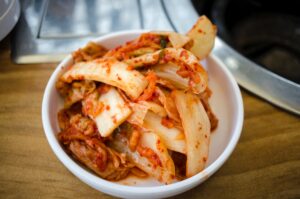
History of Kimchi
The history of kimchi dates back thousands of years in Korea. The earliest records of kimchi can be traced back to the Three Kingdoms period, which lasted from 57 BC to 668 AD. During this time, kimchi was made by fermenting vegetables in brine, and it was often stored underground to preserve it during the winter months. As time went on, kimchi became more popular and developed into the dish we know today. In the 18th and 19th centuries, a new type of kimchi was developed using chili peppers, which gave the dish its signature spicy flavor. This type of kimchi is known as gochujang, and it is still widely used in modern Korean cuisine. Today, kimchi is a staple of Korean cuisine and is enjoyed around the world. It is often served as a side dish or used as a condiment in a variety of dishes. Kimchi is also known for its health benefits, as it is rich in vitamins, fiber, and probiotics.
Recipe for Kimchi
Here is a recipe for making your own kimchi at home:
Ingredients:
- 1 head napa cabbage, chopped into bite-sized pieces
- 1/2 cup kosher salt
- 6 cloves garlic, minced
- 1 thumb-sized piece of ginger, peeled and grated
- 2 tablespoons fish sauce or shrimp sauce
- 2 tablespoons gochugaru (Korean chili flakes)
- 1 tablespoon sugar
- 4 scallions, chopped
Instructions:
- In a large bowl, mix the chopped napa cabbage with the kosher salt. Let it sit for 2 hours, stirring occasionally.
- Rinse the cabbage with cold water and drain well.
- In a separate bowl, mix together the garlic, ginger, fish sauce, gochugaru, and sugar to create a paste.
- Add the scallions and the cabbage to the paste, and mix well with your hands to ensure that the cabbage is coated in the paste.
- Transfer the mixture to a large jar or airtight container, pressing down on the cabbage to remove any air bubbles.
- Let the jar sit at room temperature for 1-2 days, then transfer it to the refrigerator to slow down the fermentation process.
- Your kimchi is ready to eat! Serve it as a side dish or use it as a condiment in a variety of dishes. The kimchi will continue to ferment in the refrigerator, so be sure to check on it regularly and eat it within a few weeks.
Sauerkraut as another supplement bomb and superfood for gut health
Sauerkraut, also known as “sour cabbage,” is a traditional dish that has been enjoyed in Germany and other parts of Europe for centuries. It is made by fermenting shredded cabbage in a saltwater brine, which creates a sour and tangy flavor. In this chapter, we will explore the history of sauerkraut and provide a recipe for making your own.
History of Sauerkraut
The history of sauerkraut can be traced back to ancient China, where it was first made over 2,000 years ago. The Chinese used a similar method of fermenting cabbage to create a dish called “pickled vegetables.” Sauerkraut was later introduced to Europe by the Tartars, a nomadic people from Central Asia, and it quickly became popular throughout the continent. In Germany, sauerkraut has been a staple food for centuries. During the winter months, when fresh produce was scarce, Germans would preserve cabbage by fermenting it in large barrels. Sauerkraut was also an important food source for sailors on long voyages, as it could be stored for months without spoiling. Today, sauerkraut is enjoyed around the world and is often used as a condiment or side dish in a variety of dishes. It is also known for its health benefits, as it is rich in vitamins, fiber, and probiotics.
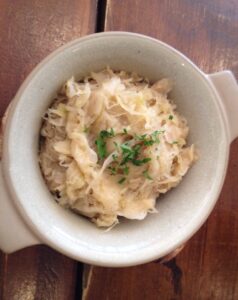
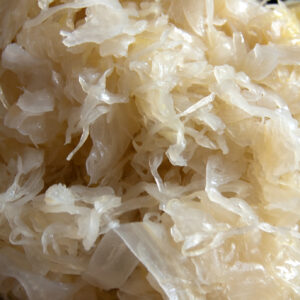
Recipe for Sauerkraut
Here is a recipe for making your own sauerkraut at home:
Ingredients:
- 1 head cabbage, finely shredded (about 2 kilogramgs)
- 3 tablespoon kosher salt
- 1 tablespoon caraway seeds (optional)
- 1 tablespoon peppercorns
Instructions:
- In a large bowl, mix the shredded cabbage with the kosher salt and caraway seeds and peppercorns (if using).
- Using your hands, massage the cabbage mixture for several minutes until it starts to release its juices.
- Transfer the cabbage mixture to a large jar or crock, pressing down on it to remove any air bubbles.
- Pour any remaining juices from the bowl over the top of the cabbage, making sure that the cabbage is completely submerged.
- Cover the jar or crock with a clean cloth or lid, and let it sit at room temperature for 3-10 days, depending on how sour you want your sauerkraut to be. The longer it ferments, the more sour it will become.
- Once your sauerkraut has reached your desired level of sourness, transfer it to a clean jar or container and store it in the refrigerator.
- Your sauerkraut is ready to eat! Serve it as a side dish or use it as a condiment in a variety of dishes. The sauerkraut will continue to ferment in the refrigerator, so be sure to check on it regularly and eat it within a few weeks.
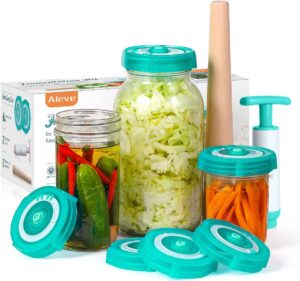
AIEVE Fermentation Lids, 6 Pack Mason Jar Fermenting Lids with Extractor Pump and Sauerkraut Pounder Fermenter Lids Fermentation Kit for Wide Mouth Mason Jars to Make Sauerkraut, Kimchi, Pickles
Price: $17.59
Superman Sauerkraut ™ -The Miracle Health Bomb
We are going to make it a same way as a regular sauerkraut, but we add more ingredients to it. If some ingredients are missing is not a big deal, but the best to have all of them. If you struggle with the heat, you can cut the quantity of spices and horse-radish. You can tailor it to your individual tastes but do try to stick to the instructions as closely as possible for the best product. Consume it daily for your health!
Ingredients:
- 1 head cabbage, finely shredded (about 2 kilogramgs)
- 3 tablespoon kosher salt
- 1 huge head of beetroot-bulb
- a smaller piece of horse-radish
- a huge head of red onion
- a piece of cucumber
- 2 bunch of scallions (about 10 scallions)
- a piece of icicle-radish or korean radish
- small amount of fresh sauerkraut or sauerkraut juice – not pasterurized (inoculating with bacteria culture)
- a piece of ginger
- 1 tablespoon caraway seeds (optional)
- 1 tablespoon black pepper
- 10 large cloves of garlic
- 2-3 tablespoon of Red chili flakes
- 1 tablespoon curcuma
Instructions:
- In a large bowl, mix the shredded cabbage, with the kosher salt and caraway seeds and black pepper, red chili flakes, curcuma.
- Grate the beetroot, radish, purple onion, and cucumber on a larger-holed grater and add itt o the cabbage-mixture.
- Grate the ginger, garlic, and horseradish on a smaller-holed grater and add itt to the mixture too.
- Chop the scallions to small pieces and add them to the mixture.
- Add the sauerkraut or sauerkraut juice as well.
- Using your hands (in gloves), massage the cabbage mixture for several minutes until it starts to release its juices.
- Transfer the cabbage mixture to a large jar or crock, pressing down on it to remove any air bubbles.
- Pour any remaining juices from the bowl over the top of the cabbage, making sure that the cabbage is completely submerged.
- Cover the jar or crock with a clean cloth or lid, and let it sit at room temperature for 3-10 days, depending on how sour you want your sauerkraut to be. The longer it ferments, the more sour it will become.
- Once your sauerkraut has reached your desired level of sourness, transfer it to a clean jar or container and store it in the refrigerator.
- Your sauerkraut is ready to eat! Serve it as a side dish or use it as a condiment in a variety of dishes. The sauerkraut will continue to ferment in the refrigerator, so be sure to check on it regularly and eat it within a few weeks.
